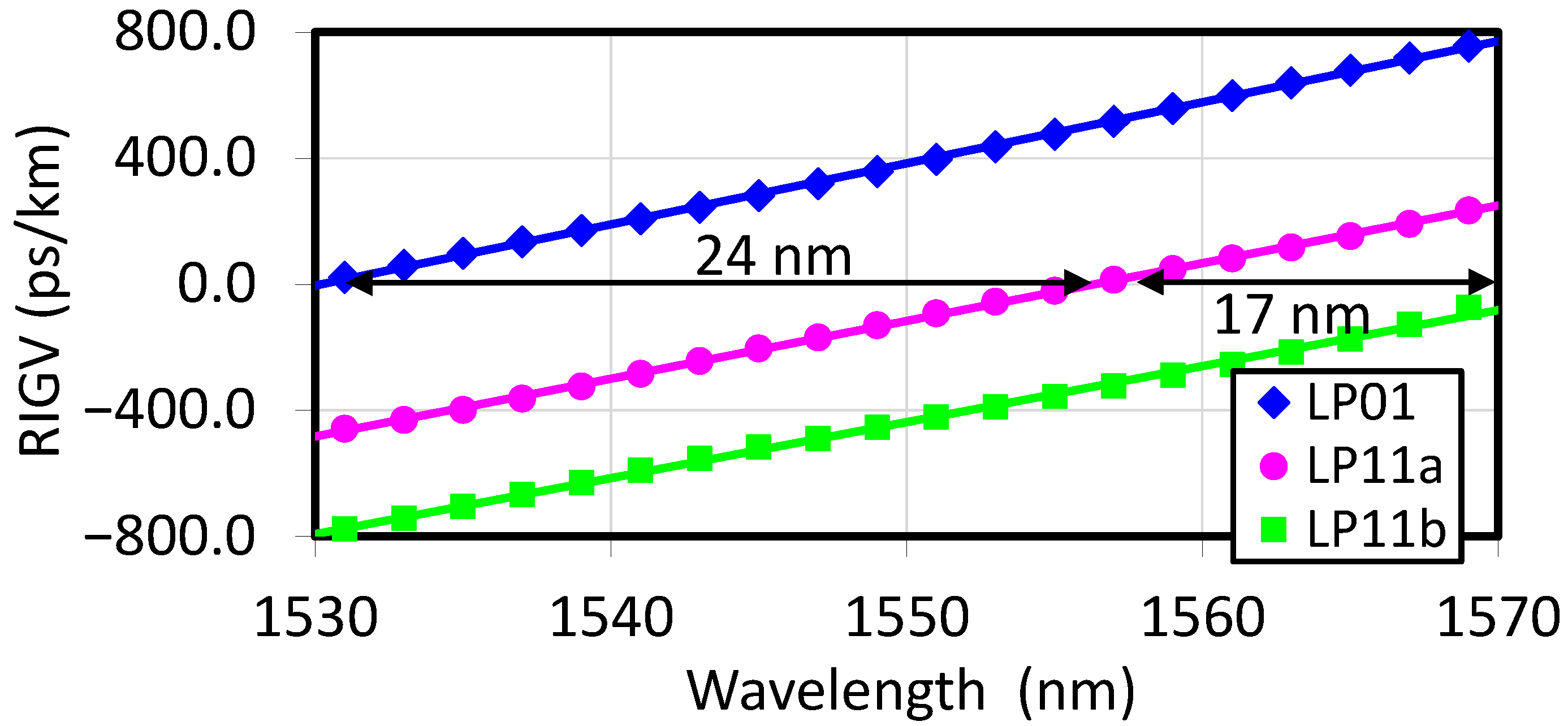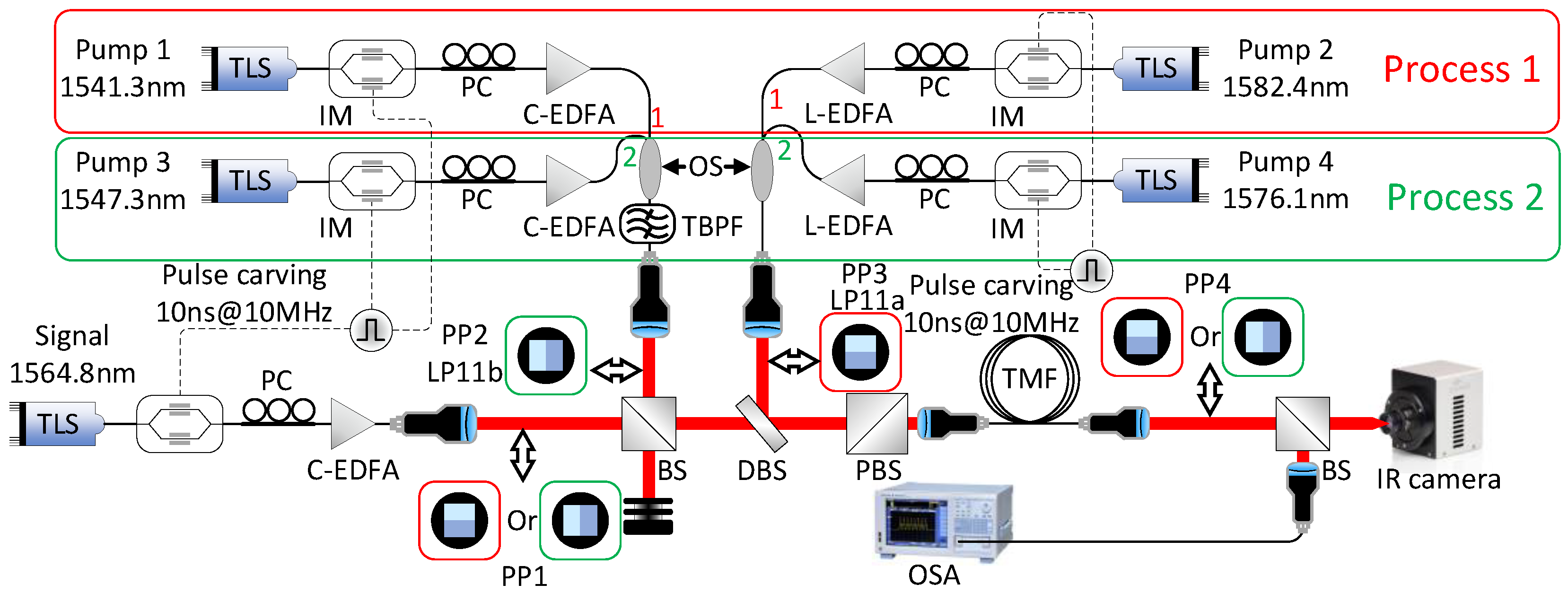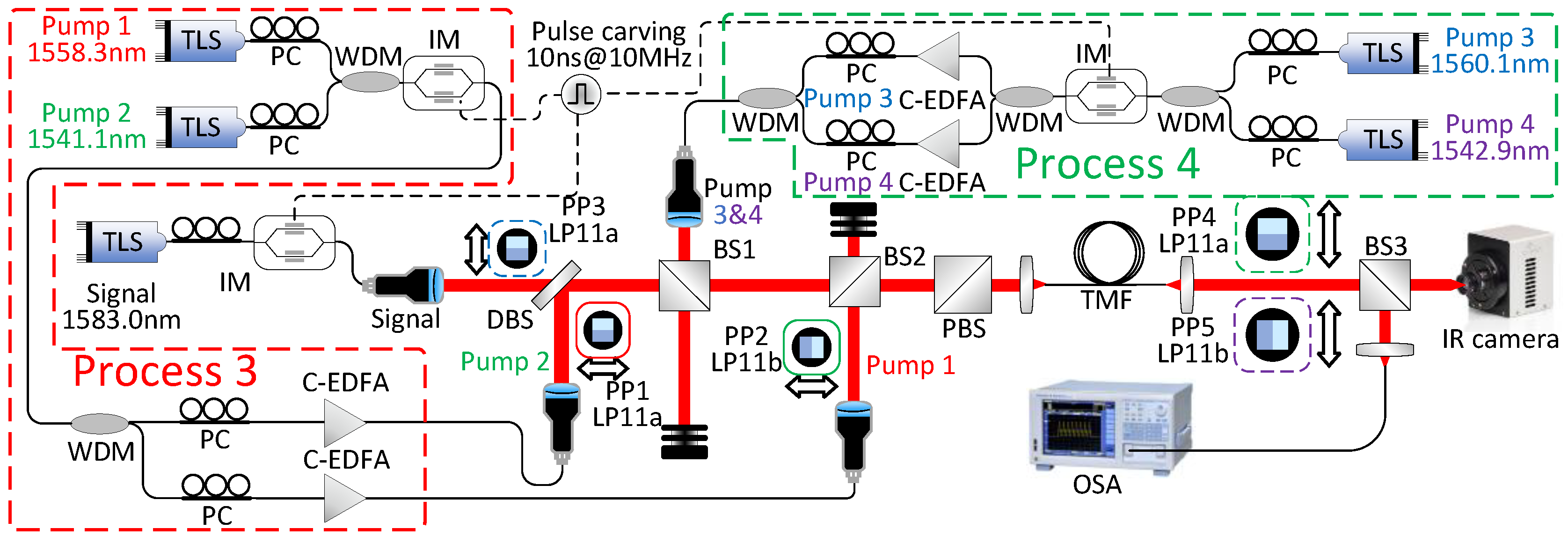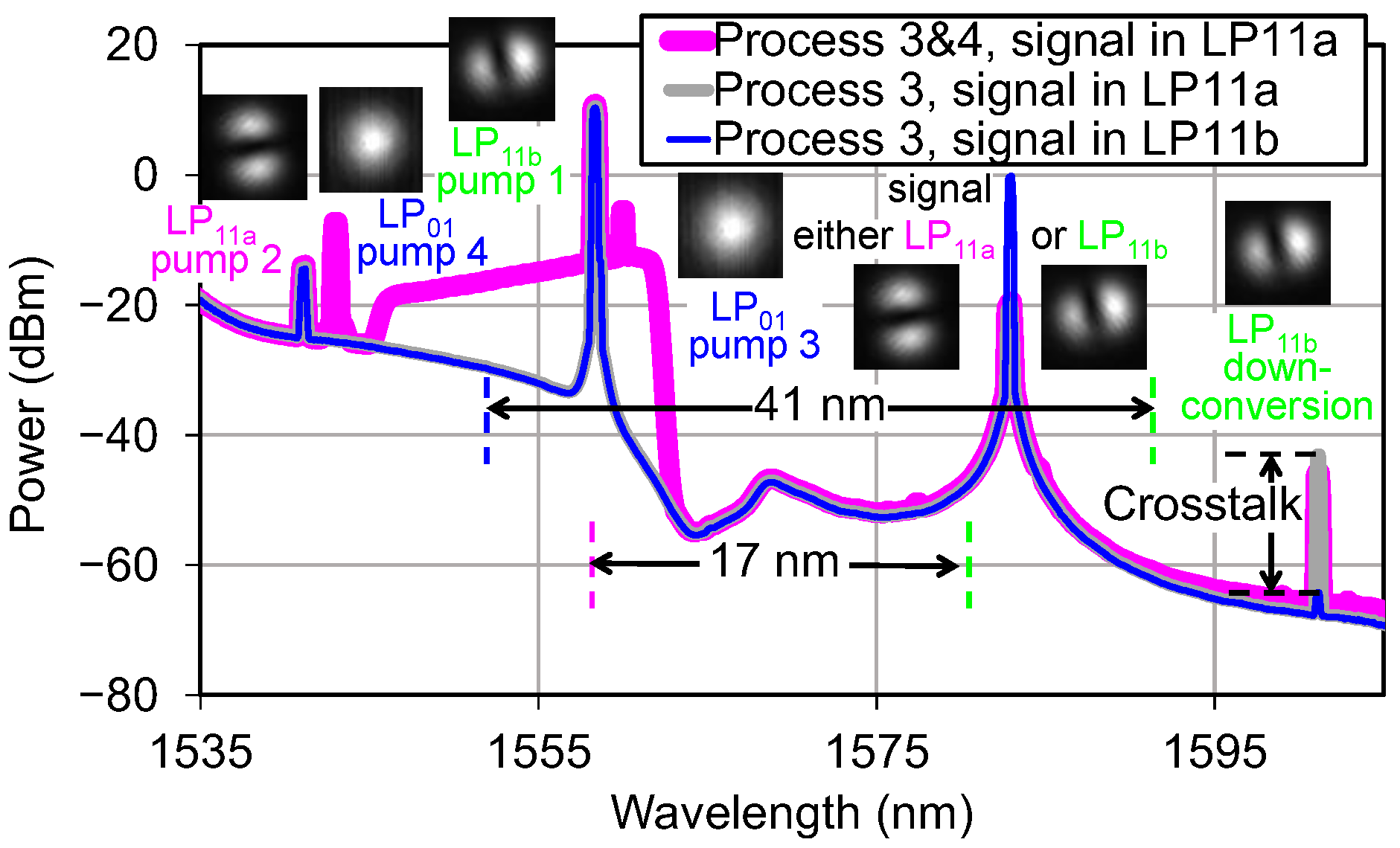Nonlinear-Optical Processing of OAM Light States in a Few-Mode Fiber
Abstract
1. Introduction
2. Experimental Investigation of OAM-Compatible χ(3) Nonlinear Processes for Spatially-Entangled State Generation and Spatial-Mode-Selective Frequency Conversion in FMF
2.1. Experiments Toward Generation of OAM-Entangled Photon Pairs
- IM-FWM process 1: With the assistance of pump 1 in mode LP11a and pump 2 in mode LP11b, a signal photon is created in mode LP11a at frequency νs, while the idler photon is created in the orthogonal mode LP11b at frequency νi.
- IM-FWM process 2: In the presence of pump 3 in mode LP11a and pump 4 in mode LP11b, a signal photon at frequency νs is created in mode LP11b, whereas the idler photon is created in the orthogonal mode LP11a at frequency νi.

- The number of photons in each spatial mode should be preserved (i.e., if the signal and idler are in two different spatial modes, then one pump should be in the signal’s spatial mode, and the other pump—in the idler’s mode);
- The group velocity at the average frequency of the two waves in one mode (LP11a in our case) should be equal to the group velocity at the average frequency of the two waves in the other mode (LP11b in our case).
2.2. Experiments on OAM-Compatible Spatial-Mode-Selective Frequency Conversion
- In the presence of pump 1 in mode LP11b and pump 2 in mode LP11a, process 3 transfers the signal in mode LP11a to a wavelength-converted beam in mode LP11b.
- In the presence of pumps 3 and 4 in mode LP01, process 4 transfers the signal in mode LP11b to the same wavelength-converted beam in mode LP11b.
3. Discussion and Conclusions
Author Contributions
Funding
Data Availability Statement
Conflicts of Interest
References
- Puttnam, B.J.; Rademacher, G.; Luís, R.S. Space-division multiplexing for optical fiber communications. Optica 2021, 8, 1186–1203. [Google Scholar] [CrossRef]
- Xavier, G.B.; Lima, G. Quantum information processing with space-division multiplexing optical fibres. Commun. Phys. 2020, 3, 9. [Google Scholar] [CrossRef]
- Bittermann, J.A.; Bulla, L.; Ecker, S.; Neumann, S.P.; Fink, M.; Bohmann, M.; Friis, N.; Huber, M.; Ursin, R. Photonic entanglement during a zero-g flight. Quantum 2024, 8, 1256. [Google Scholar] [CrossRef]
- Rübeling, P.; Heine, J.; Johanning, R.; Kues, M. Quantum and coherent signal transmission on a single-frequency channel via the electro-optic serrodyne technique. Sci. Adv. 2024, 10, eadn8907. [Google Scholar] [CrossRef]
- Chang, K.C.; Cheng, X.; Sarihan, M.C.; Vinod, A.K.; Lee, Y.S.; Zhong, T.; Gong, Y.X.; Xie, Z.; Shapiro, J.H.; Wong, F.N.; et al. 648 Hilbert-space dimensionality in a biphoton frequency comb: Entanglement of formation and Schmidt mode decomposition. npj Quan. Inf. 2021, 7, 48. [Google Scholar] [CrossRef]
- Chang, K.C.; Sarihan, M.C.; Cheng, X.; Zhang, Z.; Wong, C.W. Large-alphabet time-bin quantum key distribution and Einstein–Podolsky–Rosen steering via dispersive optics. Quan. Sci. Technol. 2024, 9, 015018. [Google Scholar] [CrossRef]
- Löffler, W.; Euser, T.G.; Eliel, E.R.; Scharrer, M.; Russell, P.S.J.; Woerdman, J.P. Fiber transport of spatially entangled photons. Phys. Rev. Lett. 2011, 106, 240505. [Google Scholar] [CrossRef]
- Kang, Y.; Ko, J.; Lee, S.M.; Choi, S.K.; Kim, B.Y.; Park, H.S. Measurement of the entanglement between photonic spatial modes in optical fibers. Phys. Rev. Lett. 2012, 109, 020502. [Google Scholar] [CrossRef]
- Cozzolino, D.; Polino, E.; Valeri, M.; Carvacho, G.; Bacco, D.; Spagnolo, N.; Oxenløwe, L.K.K.; Sciarrino, F. Air-core fiber distribution of hybrid vector vortex-polarization entangled states. Adv. Photonics 2019, 1, 046005. [Google Scholar] [CrossRef]
- Essiambre, R.J.; Mestre, M.A.; Ryf, R.; Gnauck, A.H.; Tkach, R.W.; Chraplyvy, A.R.; Sun, Y.; Jiang, X.; Lingle, R. Experimental investigation of inter-modal four-wave mixing in few-mode fibers. IEEE Photonics Technol. Lett. 2013, 25, 539–542. [Google Scholar] [CrossRef]
- Anjum, O.F.; Guasoni, M.; Horak, P.; Jung, Y.; Petropoulos, P.; Richardson, D.J.; Parmigiani, F. Polarization-insensitive four-wave-mixing-based wavelength conversion in few-mode optical fibers. J. Light. Technol. 2018, 36, 3678–3683. [Google Scholar] [CrossRef]
- Parmigiani, F.; Horak, P.; Jung, Y.; Grüner-Nielsen, L.; Geisler, T.; Petropoulos, P.; Richardson, D.J. All-optical mode and wavelength converter based on parametric processes in a three-mode fiber. Opt. Express 2017, 25, 33602–33609. [Google Scholar] [CrossRef]
- Anjum, O.F.; Guasoni, M.; Horak, P.; Jung, Y.; Suzuki, M.; Hasegawa, T.; Bottrill, K.; Richardson, D.J.; Parmigiani, F.; Petropoulos, P. Selective wavelength conversion in a few-mode fiber. Opt. Express 2019, 27, 24072–24081. [Google Scholar] [CrossRef] [PubMed]
- Rottwitt, K.; Koefoed, J.G.; Christensen, E.N. Photon-pair sources based on intermodal four-wave mixing in few-mode fibers. Fibers 2018, 6, 32. [Google Scholar] [CrossRef]
- Guo, C.; Su, J.; Zhang, Z.; Cui, L.; Li, X. Generation of telecom-band correlated photon pairs in different spatial modes using few-mode fibers. Opt. Lett. 2019, 44, 235–238. [Google Scholar] [CrossRef]
- Li, X.; Cui, L.; Guo, X.; Ou, Z.Y.; Vasilyev, M. Fiber-based sources of quantum light for quantum information processing. In Proceedings of the Asia Communications and Photonics Conference (ACP), Shanghai, China, 24–27 October 2021. paper M4A.1. [Google Scholar]
- Shamsshooli, A.; Guo, C.; Parmigiani, F.; Li, X.; Vasilyev, M. Toward generation of spatially-entangled photon pairs in a few-mode fiber. In Proceedings of the Conference on Lasers and Electro-Optics (CLEO), Washington DC, USA, 10–15 May 2020. paper JTh2A.27. [Google Scholar]
- Shamsshooli, A.; Guo, C.; Parmigiani, F.; Li, X.; Vasilyev, M. Progress Toward Generation of Spatially-Entangled Photon Pairs in a Few-Mode Fiber. In Proceedings of the IEEE Photonics Conference (IPC), Vancouver, BC, Canada, 28 September–1 October 2020. paper MI2.2. [Google Scholar]
- Shamsshooli, A.; Guo, C.; Parmigiani, F.; Li, X.; Vasilyev, M. Progress Toward Spatially-Entangled Photon-Pair Generation in a Few-Mode Fiber. IEEE Photonics Technol. Lett. 2021, 33, 864–867. [Google Scholar] [CrossRef]
- Shamsshooli, A.; Guo, C.; Parmigiani, F.; Li, X.; Vasilyev, M. Toward generation of orbital-angular-momentum-entangled photon pairs in a few-mode fiber. In Proceedings of the Frontiers in Optics conference, Washington DC, USA, 14–17 September 2020. paper FM1D.2. [Google Scholar]
- Shibahara, K.; Mizuno, T.; Ono, H.; Nakajima, K.; Miyamoto, Y. Long-haul DMD-unmanaged 6-mode-multiplexed transmission employing cyclic mode-group permutation. In Proceedings of the Optical Fiber Communication (OFC) conference, San Diego, CA, USA, 8–12 March 2020. paper Th3H.3. [Google Scholar]
- Kwon, Y.B.; Vasilyev, M. Mode-selective frequency up-conversion in a χ(2) waveguide. Proc. SPIE 2014, 8964, 89640N. [Google Scholar]
- Kwon, Y.B.; Giribabu, M.; Li, L.; Samudrala, S.C.; Langrock, C.; Fejer, M.M.; Vasilyev, M. Experimental demonstration of spatial-mode-selective frequency up-conversion in a multimode χ(2) waveguide. In Proceedings of the Conference on Lasers and Electro-Optics (CLEO), San Jose, CA, USA, 5–10 June 2016. paper STh3P.4. [Google Scholar]
- Kwon, Y.B.; Giribabu, M.; Langrock, C.; Fejer, M.M.; Vasilyev, M. Single-photon-level spatial-mode-selective frequency up-conversion in a multimode χ(2) waveguide. In Proceedings of the Conference on Lasers and Electro-Optics (CLEO), San Jose, CA, USA, 14–19 May 2017. paper FF2E.1. [Google Scholar]
- Shamsshooli, A.; Guo, C.; Parmigiani, F.; Li, X.; Vasilyev, M. Mode-Selective Frequency Conversion in a Three-Mode Fiber. In Proceedings of the Conference on Lasers and Electro-Optics (CLEO), San Jose, CA, USA, 10–15 May 2020. paper SM3P.3. [Google Scholar]
- Shamsshooli, A.; Guo, C.; Vasilyev, M.; Parmigiani, F.; Li, X. Reconfigurable mode-selective frequency conversion in a three-mode fiber. In Proceedings of the IEEE Photonics Conference (IPC), Vancouver, BC, Canada, 28 September–1 October 2020. paper ThF1.2. [Google Scholar]
- Shamsshooli, A.; Guo, C.; Parmigiani, F.; Li, X.; Vasilyev, M. Reconfigurable Spatial-Mode-Selective Frequency Conversion in a Three-Mode Fiber. IEEE Photonics Technol. Lett. 2021, 33, 860–863. [Google Scholar] [CrossRef]
- Shamsshooli, A.; Kwon, Y.B.; Guo, C.; Parmigiani, F.; Li, X.; Langrock, C.; Fejer, M.M.; Vasilyev, M. Spatial-Mode-Selective Frequency Conversion. In Proceedings of the Photonics in Switching and Computing Conference, Washington, DC, USA, 27–29 September 2021. paper Tu4A.1. [Google Scholar]
- Shamsshooli, A.; Guo, C.; Vasilyev, M.; Parmigiani, F.; Li, X.; Akasaka, Y.; Palacharla, P. Emerging applications of wavelength conversion. In Proceedings of the IEEE Photonics Conference (IPC), Vancouver, BC, Canada, 17–21 October 2021. paper ThE2.1. [Google Scholar]
- Shamsshooli, A.; Kwon, Y.B.; Guo, C.; Vasilyev, M. Devices for quantum communication over mode-division-multiplexing systems. Proc. SPIE 2023, 12446, 124460E. [Google Scholar]
- Shamsshooli, A.; Guo, C.; Parmigiani, F.; Li, X.; Vasilyev, M. Toward OAM-selective frequency conversion in a three-mode fiber. In Proceedings of the Conference on Lasers and Electro-Optics (CLEO), San Jose, CA, USA, 11–13 May 2021. paper SM1F.5. [Google Scholar]
- Choi, S.-K.; Vasilyev, M.; Kumar, P. Noiseless Optical Amplification of Images. Phys. Rev. Lett. 1999, 83, 1938–1941, Erratum in Phys. Rev. Lett. 2000, 84, 1361. [Google Scholar] [CrossRef]
- Vasilyev, M.; Stelmakh, N.; Kumar, P. Phase-sensitive image amplification with elliptical Gaussian pump. Opt. Express 2009, 17, 11415–11425. [Google Scholar] [CrossRef] [PubMed]
- Vasilyev, M.; Stelmakh, N.; Kumar, P. Estimation of the spatial bandwidth of an optical parametric amplifier with plane-wave pump. J. Mod. Opt. 2009, 56, 2029–2033. [Google Scholar] [CrossRef]
- Vasilyev, M.; Kumar, P. Frequency up-conversion of quantum images. Opt. Express 2012, 20, 6644–6656. [Google Scholar] [CrossRef] [PubMed]
- Vasilyev, M.; Annamalai, M.; Stelmakh, N.; Kumar, P. Quantum properties of a spatially-broadband traveling-wave phase-sensitive optical parametric amplifier. J. Mod. Opt. 2010, 57, 1908–1915. [Google Scholar] [CrossRef]
- Annamalai, M.; Stelmakh, N.; Vasilyev, M.; Kumar, P. Spatial modes of phase-sensitive parametric image amplifiers with circular and elliptical Gaussian pumps. Opt. Express 2011, 19, 26710–26724. [Google Scholar] [CrossRef]
- Annamalai, M.; Stelmakh, N.; Kumar, P.; Vasilyev, M. Compact representation of the spatial modes of a phase-sensitive image amplifier. Opt. Express 2013, 21, 28134–28153. [Google Scholar] [CrossRef]
- Levandovsky, D.; Vasilyev, M.; Kumar, P. Perturbation theory of quantum solitons: Continuum evolution and optimum squeezing by spectral filtering. Opt. Lett. 1999, 24, 43–45. [Google Scholar] [CrossRef]
- Levandovsky, D.; Vasilyev, M.; Kumar, P. Soliton squeezing in a highly transmissive nonlinear optical loop mirror. Opt. Lett. 1999, 24, 89–91, Erratum in Opt. Lett. 1999, 24, 423. [Google Scholar] [CrossRef]
- Levandovsky, D. Quantum Noise Suppression in Optical Fibers. Ph.D. Thesis, Northwestern University, Evanston, IL, USA, 1999. [Google Scholar]
- Annamalai, M.; Vasilyev, M. Phase-sensitive multimode parametric amplification in a parabolic-index waveguide. IEEE Photonics Technol. Lett. 2012, 24, 1949–1952. [Google Scholar] [CrossRef]
- Cui, L.; Liu, X.; Guo, C.; Zhang, Z.; Zhao, N.; Vasilyev, M.; Li, X. Measurement of effective nonlinear coefficients in few-mode fibers. Opt. Lett. 2019, 44, 5768–5771. [Google Scholar] [CrossRef]
- Zhang, Z.; Cheng, H.; Guo, C.; Cui, L.; Zhang, Y.; Mo, Q.; Yu, H.; Vasilyev, M.; Li, X. Investigation of Spontaneous Raman Scattering in Few-Mode Fibers: Dependence on Polarization and Spatial Modes. J. Light. Technol. 2021, 39, 6281–6287. [Google Scholar] [CrossRef]
- Huo, N.; Cheng, H.; Zhu, S.; Guo, C.; Zhang, Y.; Mo, Q.; Cui, L.; Vasilyev, M.; Li, X. Gain-equalizable few-mode fiber optical parametric amplifier in telecom band. Opt. Comm. 2022, 508, 127735. [Google Scholar] [CrossRef]
- Fontaine, N.K.; Ryf, R.; Chen, H.; Neilson, D.; Carpenter, J. Design of high order mode-multiplexers using multiplane light conversion. In Proceedings of the European Conference on Optical Communications (ECOC), Gothenburg, Sweden, 17–21 September 2017. [Google Scholar]
- Ataie, V.; Myslivets, E.; Kuo, B.P.-P.; Alic, N.; Radic, S. Spectrally Equalized Frequency Comb Generation in Multistage Parametric Mixer With Nonlinear Pulse Shaping. J. Light. Technol. 2014, 32, 840–846. [Google Scholar] [CrossRef]






Disclaimer/Publisher’s Note: The statements, opinions and data contained in all publications are solely those of the individual author(s) and contributor(s) and not of MDPI and/or the editor(s). MDPI and/or the editor(s) disclaim responsibility for any injury to people or property resulting from any ideas, methods, instructions or products referred to in the content. |
© 2025 by the authors. Licensee MDPI, Basel, Switzerland. This article is an open access article distributed under the terms and conditions of the Creative Commons Attribution (CC BY) license (https://creativecommons.org/licenses/by/4.0/).
Share and Cite
Guo, C.; Shamsshooli, A.; Parmigiani, F.; Li, X.; Vasilyev, M. Nonlinear-Optical Processing of OAM Light States in a Few-Mode Fiber. Photonics 2025, 12, 233. https://doi.org/10.3390/photonics12030233
Guo C, Shamsshooli A, Parmigiani F, Li X, Vasilyev M. Nonlinear-Optical Processing of OAM Light States in a Few-Mode Fiber. Photonics. 2025; 12(3):233. https://doi.org/10.3390/photonics12030233
Chicago/Turabian StyleGuo, Cheng, Afshin Shamsshooli, Francesca Parmigiani, Xiaoying Li, and Michael Vasilyev. 2025. "Nonlinear-Optical Processing of OAM Light States in a Few-Mode Fiber" Photonics 12, no. 3: 233. https://doi.org/10.3390/photonics12030233
APA StyleGuo, C., Shamsshooli, A., Parmigiani, F., Li, X., & Vasilyev, M. (2025). Nonlinear-Optical Processing of OAM Light States in a Few-Mode Fiber. Photonics, 12(3), 233. https://doi.org/10.3390/photonics12030233




